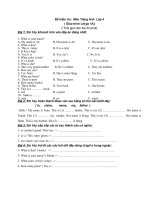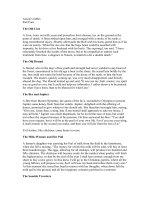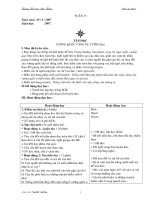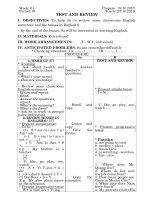English 4- week 33
Bạn đang xem bản rút gọn của tài liệu. Xem và tải ngay bản đầy đủ của tài liệu tại đây (110.72 KB, 9 trang )
<span class='text_page_counter'>(1)</span><div class='page_container' data-page=1>
Week 33 Period 127
Date of planning: 6/5/2017
<b>UNIT 19: WHAT ANIMAL DO YOU WANT TO SEE?</b>
<b>Lesson 2: 4-5-6</b>
<b>I. AIMS. </b>
By the end of this lesson, Ps will be able to listen and complete the sentences about
four characters and complete the sentences about animals.
1. Knowledge:
Sentence patterns: revision
Vocabulary: revision
<b>2. Skills: speaking, listening and reading</b>
3. Attitude: Ps know to protect animals.
II. TEACHING METHODS:
- Work in pairs , individual, in groups ….
III. TEACHING AIDS:
<i>1. Teacher’s: student’s and teacher’s book, pictures, cassette.</i>
<i>2. Students’: books, notebooks, workbooks.</i>
<i>3. Class organization:</i>
Class Date of teaching Absent pupils
4A
4B
………
………
IV. PROCEDURE:
Teacher’s activities Pupils’ activities
<b>I. Warm up:(5’)</b>
Spend a few minutes revising the previous lesson by
asking some ps to explain why they like and do not
like some animals.
Work in pairs.
<b>II. New lesson:(30’)</b>
<b> 4. Listen and write. (12’)</b>
a. Pre-listening:
- T looks at the books and sets the table:
<i>How many pictures? What’s this? …</i>
- Tell the class that they are going to listen to four
dialogues and complete the sentences about Linda,
Peter, Mai and Nam.
- Ask them to look at the four incomplete sentences
and guess the possible reasons.
b. While-listening:
- Play the recording three times for ps to listen and
complete the sentences and check their answers..
- Get them to swap their answers before you check as
a class.
Key: 1. big 2. fast 3. funny 4. Scrary
Look at the pictures.
Listen to the dialogues.
Ps answer the T’s
questions.
</div>
<span class='text_page_counter'>(2)</span><div class='page_container' data-page=2>
c. Post listening:
- Play the game: Lucky numbers.
<b>5. Look and write.(12’)</b>
<b>a. Pre- writing:</b>
- Set the scence:
- Tell ps that they are going to complete the sentences
about animals, using the picture cues.
- Ask them to look at the four pictures to identify the
zoo animals and the possible adjectives to express the
reasons.( 1. Zebras/ beautiful. 2. Crocodiles/ scary 3.
Bears/ big 4. Kangaroos/ fast). Then ask them to
read the sentences and complete them. If necessary,
get ps to work in pairs.
b. While- writing:
- Set a time limit for ps to do the task independently.
Go around offering help, if necessary.
- Get them to swap their answers before checking as a
class. If there is enough time, invite some of them to
read the sentences aloud.
Key: 1. zebras, they are beautiful 2. crocodiles,
they are scary
3. bears, they are big 4. Kangaroos,
they are fast
<b>c. Post writing:</b>
- Ask Ps to play a game: Whisper
<b>6. Let’s sing.(8’)</b>
<i>- Tell ps that they are going to sing the song Why or</i>
<i>why not? Teach the song, following the procedure in</i>
Teaching the unit components in introduction.
- Have them read each line of the lyrics aloud. Check
comprehension.
- Play the recording all the way through. Ask ps to do
choral and individual repetition of the song line by
line.
- Play the recording again and get ps to sing along.
- Divide the class into two groups: one sings the
<b>questions and the other sings the answers. </b>
Exchange
Play the game.
Look at the pictures.
Listen to the teacher.
Identify the what someone
is doing.
Ps complete.
Ps do the task.
Swap their answers.
Play the game.
Listen to the teacher.
Ps work in groups of three.
Ps sing.
<b>III. Consolidation:(3’)</b>
? What’s the content of the lesson? T- Ps
<b>IV. Home-link: (2’)</b>
- Do exercises in the workbook. Learn by heart the
new words and structures.
</div>
<span class='text_page_counter'>(3)</span><div class='page_container' data-page=3>
* Comments:
………
………
……….
Week 33 Period 128
Date of planning: 6/5/2017
<b>UNIT 19: WHAT ANIMAL DO YOU WANT TO SEE?</b>
<b>Lesson 3: 1-2-3</b>
<b> I. AIMS. </b>
By the end of this lesson, Ps will be able to pronounce three- syllable words with the
stress on the first syllable: ‘crocodile, ‘elephant, ‘ beautiful, ‘wonderful.
1. Knowledge:
Sentence patterns: revision
Vocabulary: revision
<b>2. Skills: speaking, listening and reading</b>
3. Attitude: Ps know to pronounce three- syllable words with the stress on the first
syllable.
II. TEACHING METHODS:
- Work in pairs , individual, in groups ….
III. TEACHING AIDS:
<i>1. Teacher’s: student’s and teacher’s book, pictures, cassette.</i>
<i>2. Students’: books, notebooks, workbooks.</i>
<i>3. Class organization:</i>
Class Date of teaching Absent pupils
4A
4B
………
………
IV. PROCEDURE:
Teacher’s activities Pupils’ activities
<b>I. Warm up:(5’)</b>
Spend a few minutes revising the previous lesson by
calling some ps to the front of the class to sing the
song Why or why not? Have the class listen and clap
their hands.
Ps play the game.
<b>II. New lesson:(30’)</b>
<b>1. Listen and repeat. (12’)</b>
- Tell ps that they are going to practise saying these
words: <i> ‘crocodile,’elephant, ‘wonderful and</i>
<i>‘beautiful</i>
<i>- First, put the words ‘crocodile,’elephant,</i>
<i>‘wonderful and ‘beautiful on the board, with the</i>
stress marks. Play the recording and ask ps to repeat
the words a few times. Then put the four sentences on
Listen to the teacher.
</div>
<span class='text_page_counter'>(4)</span><div class='page_container' data-page=4>
the board. Play the recording more than once, if
necessary, and let ps say the sentences, paying
attention to the target words and stress.
- Do the choral and individual repetition of the words
and sentences until ps feel confident.
- Get some ps to say the sentences, while the rest of
the class claps at the stressed syllables of the target
words. Correct the pronounciation, if necessary.
- If time allows, ask them to make sentences with the
words and say them aloud.
<b>2. Listen and circle. Then say the sentences aloud.</b>
<b>(12’)</b>
- Tell ps that they are going to listen to the recording
and circle the correct words
- Ask them to look at the sentences and guess the
words to fill the gaps.
- Play the recording for ps to listen and circle the
answers.
- Play the recording again so they can check their
answers.
- Get ps to swap their answers before checking as a
class.
- Then ask them to read aloud the answers.
Key: 1b 2b 3 a 4b
<b>3. Let’s chant.(8’)</b>
<i>- Tell ps that they are going to say the chant I want to</i>
<i>go to the zoo. Follow the procedure in Teaching the</i>
unit components in introduction.
- Have them read the chant and check comprehension.
- Play the recording a few times for ps to do choral
and individual repetition. Show them how to chant
and do actions. Call two groups to give a
demonstration.
- Get groups to sit opposite of each other and practise
chanting and doing actions. Go around offering help,
if necessary.
- Call two groups to the front of the class to chant and
do actions. The rest of the class claps along to the
<b>rhythm. </b>
Listen and repeat.
Ps perform.
Listen to the teacher.
Read the sentences.
Listen and circle.
Swap their answers.
Read aloud .
Listen the the teacher.
Read the chant.
Listen and sing.
Practise chanting and
doing actions in groups.
Sing in groups.
<b>III. Consolidation:(3’)</b>
? What’s the content of the lesson? T- Ps
<b>IV. Home-link: (2’)</b>
</div>
<span class='text_page_counter'>(5)</span><div class='page_container' data-page=5>
new words and structures.
* Comments:
………
………
……….
Week 33 Period 129
Date of planning: 6/5/2017
<b>UNIT 19: WHAT ANIMAL DO YOU WANT TO SEE?</b>
<b>Lesson 3: 4-5-6</b>
<b>I. AIMS. </b>
By the end of this lesson, Ps will be able to read and complete the email about Mai
and Nam’s visit to the zoo and write a short paragraph about why they want to go to
the zoo.
1. Knowledge:
Sentence patterns: revision
Vocabulary: revision
<b>2. Skills: speaking, listening and reading</b>
3. Attitude: Ps know about writing a short paragraph about why they want to go to
the zoo.
II. TEACHING METHODS:
- Work in pairs , individual, in groups ….
III. TEACHING AIDS:
<i>1. Teacher’s: student’s and teacher’s book, pictures, cassette.</i>
<i>2. Students’: books, notebooks, workbooks.</i>
<i>3. Class organization:</i>
Class Date of teaching Absent pupils
4A
4B
………
………
IV. PROCEDURE:
Teacher’s activities Pupils’ activities
<b>I. Warm up:(5’)</b>
Spend a few minutes revising the previous lesson.
Have the class pronounce three- syllable words with
the stress on the first syllable. Remind them to use a
louder voice for the second syllable. You may ask
them to clap at the stressed syllable as they say the
words. Here are some words you may use:
<i>‘crocodile,’elephant, ‘wonderful and ‘beautiful…</i>
Say the words and
syllables.
</div>
<span class='text_page_counter'>(6)</span><div class='page_container' data-page=6>
- Ask Ps to look at the text and pictures , ask some
questions
- Tell the class that they are going to read the email
about Nam and Mai’s visit to the zoo and complete
the paragraph. Eplain the meaning of the new words
perhaps and dangerous.
- Tell ps to read the incomplete paragraph first. Then
let them read the email and focus on the information
needed to fill the gaps
b. While-reading.
- Give them time to do the task independently. Go
around and offer help, if necessary.
- Get ps to swap their answers before checking as a
class.
Key: 1. animals 2. beautiful/ friendly/ scary 3.
big/ dangerous
4. monkeys 5 funny
c. Post- reading.
- Play the game: Whishper
<b>5. Let’s write. (12’)</b>
a. Pre- writing
- Ask Ps to answer T’s questions.
- Tell ps that they are going to write a short paragraph
about why they want to go to the zoo, what animal
they like and do not like, and the reasons. Remind
them to use the guided questions and the words in the
book.
- Have them work in pairs or groups to discuss what
they are going to write
b. While-writing.
- Give ps time to do the task independently. Go
around offering help, if necessary.
- Get them to swap their answers before checking as a
class. If there is time, ask one ps to write the answer
on the board.
c. Post writing.
- Play the game: Musical box
<b>6. Project. (8’)</b>
- Tell ps that they are going to draw and colour their
favourite animals and tell the class why they like it.
- Give them enough time to do the drawing. Go
around offering help, if necssary. If there is not
enough time, you may ask ps to do the task as
Answer theT’s questions.
Listen to the teacher.
Work in pairs .
Do the task.
Ps swap.
Play the game.
Answer the T’s questions.
Listen to the teacher.
Work in pairs/ groups.
Do the task independently.
Swap their answers.
Play the game.
</div>
<span class='text_page_counter'>(7)</span><div class='page_container' data-page=7>
homework.
- Ask ps to work in pairs or groups to brainstorm
possible sentences to describle their favourite animals
- Call some of them to the front of the class to talk
<b>about their favourite animal. </b>
Work in pairs or groups.
Ps talk about their
favourite animal.
<b>III. Consolidation:(3’)</b>
? What’s the content of the lesson? T- Ps
<b>IV. Home-link: (2’)</b>
- Do exercises in the workbook. Learn by heart the
new words and structures.
Individually
* Comments:
………
………
……….
Week 33 Period 130
Date of planning: 6/5/2017
<b>UNIT 20: WHAT ARE YOU GOING TO DO THIS SUMMER?</b>
<b>Lesson 1: 1-2</b>
<b>I. AIMS. </b>
By the end of this lesson, Ps will be able to ask and answer question about where
someone plans to go, using Where are you going this summer? I’m going to ….
1. Knowledge:
Sentence patterns: Where are you going this summer? I’m going to ….
Vocabulary: review
<b>2. Skills: speaking, listening and reading</b>
3. Attitude: Ps know to ask and answer question about where someone plans to go
II. TEACHING METHODS:
- Work in pairs , individual, in groups ….
III. TEACHING AIDS:
<i>1. Teacher’s: student’s and teacher’s book, pictures, cassette.</i>
<i>2. Students’: books, notebooks, workbooks.</i>
<i>3. Class organization:</i>
Class Date of teaching Absent pupils
4A
4B
………
………
IV. PROCEDURE:
Teacher’s activities Pupils’ activities
<b>I. Warm up:(5’)</b>
</div>
<span class='text_page_counter'>(8)</span><div class='page_container' data-page=8>
some Ps to go to the front of the class to say the chant
I want to go to the zoo, while the class claps hands or
does actions.
<b>II. New lesson:(30’)</b>
<b> 1. Look, listen and repeat.(8’)</b>
- Tell ps that they are going to find out about how to
ask and answer questions about where someone plans
to go.
- Ask them look at the pictures and asnwer questions
such as: Who are they? What are they talking about? (
<i>Picture a: Tom, Phong and Mai are talking about the</i>
<i>summer holiday. , Picture b: Tom asks phong Where</i>
<i>are you going this summer? And Pong answers I’m</i>
<i>going to Ha Long Bay. Picture c and d: Mai and Tom</i>
<i>tell their plans, using I’m going to Phu Quoc and I’m</i>
<i>going to stay at home.)</i>
- Play the recording a few times for ps to listen and
repeat. Do choral and individually repetition, pointing
to the characters speaking.
<b>- Play the recording again for Ps to listen and repeat.</b>
<b>2. Point and say. (16’)</b>
a. Vocabulary:
- Review
- Checking: Slap the board
b. Model sentences:
<i>A: Where are you going to this summer?</i>
<i>B: I’m going to Phu Quoc.</i>
- Concept check: intonation, using
c. Practice:
- Tell ps that they are going to practise asking and
answering questions about where someone plans to
go.
<b>- Have them look at the bubbles to understand how</b>
the language is used. Then ask them to look at the
four pictures to identify the four places in Viet Nam.
- Point to the first picture and model the task with a
pupil, using the sentences in the bubbles and the
<i>words under the first picture.( Teacher: Where are</i>
<i>you going this summer?</i>
<i>Ps: I’m going to Phu Quoc)</i>
Do choral and individual repetition and then practise
in pairs. Repeat the same procedure with the rest of
Look and listen
Look at the pictures and
answer the questions.
Listen and repeat in choral
and individual.
Look, listen and repeat in
choral then individual.
Listen and repeat.
T – W – C
H – H
O – P -> C – P
Ps practise asking and
answering.
</div>
<span class='text_page_counter'>(9)</span><div class='page_container' data-page=9>
the pictures.
- Ask them practise in pairs , using the prompts in the
bubbles and the words under the pictures.
- Select some ps to role- play the dialogue in front of
the class. Monitor the activity and offer help, if
necessary.
<b>* Work in pairs. Ask your partners where they are</b>
<b>goin this summer.(6’)</b>
- Tell Ps that they are going to practise using Where
are you goin this summer? I’m going to….
- First, ask them to suggest some places to go in
summer and write them on the board. Then have them
work in pairs: one Ps asks the question and the other
gives the answer.
- Select some pairs of Ps to role play the dialogue in
<b>front of the class. </b>
Role play
Listen.
Work in pairs to ask and
asnswer.
Ps act out.
<b>III. Consolidation:(3’)</b>
? What’s the content of the lesson? T- Ps
<b>IV. Home-link: (2’)</b>
- Do exercises in the workbook. Learn by heart the
new words and structures.
Individually
* Comments:
………
………
……….
</div>
<!--links-->









